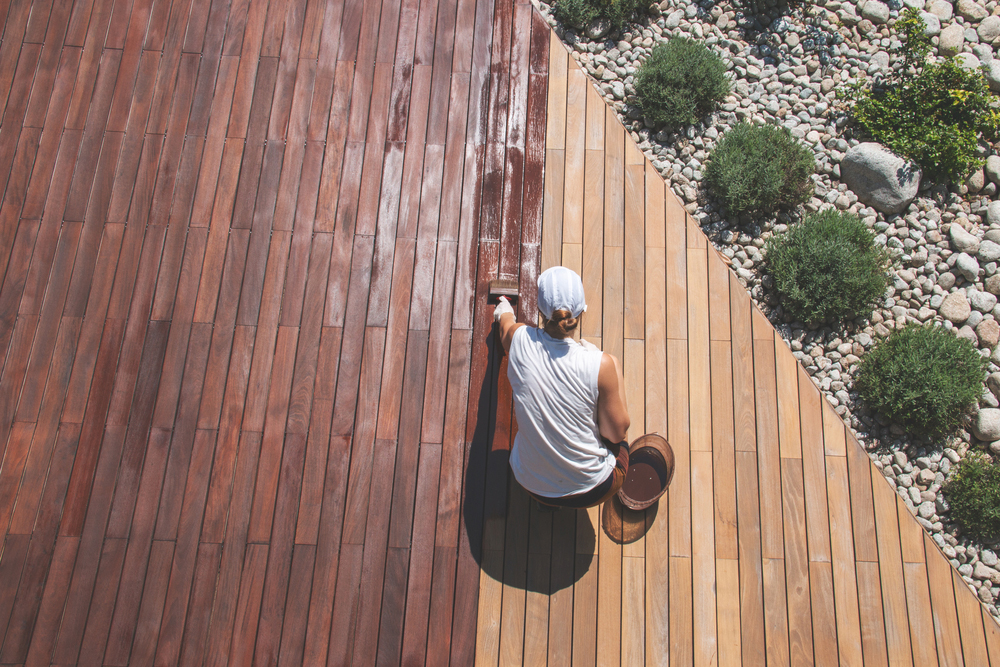Should You Seal or Stain Your Deck?

Deck Sealing vs. Staining: What’s the Difference?
A deck is an important extension of the home, providing both indoor/outdoor living and additional living space to enjoy during the warmer months. But how do you maintain this investment long-term? We discuss deck sealing and staining, including their differences, below.
Want to skip the sealing and staining altogether? Check out composite decking options from TimberTech®.
What is Deck Sealing?
Deck sealing is the process of coating your softwood decking with a sealant that provides additional moisture and UV protection. Most decks are made from softwood species like pine because the material is significantly less expensive than hardwood species like oak or walnut. This creates the need for additional UV and moisture resistance through the sealing process. Sealing is a great option if you’re already happy with the color of your deck and you’re just looking to preserve its condition.
Pros and Cons of Deck Sealing
The biggest benefit of deck sealing is that it preserves the longevity of your deck. If you diligently keep up on sealing your deck every 1-2 years, you can extend its overall lifespan. Deck sealing also provides the homeowner with benefits like protection against UV damage, moisture, mold, and insects.
The main drawback to deck sealing is that you need to repeat the process every 1-2 years. The sealant only lasts so long against the elements, which creates the need for resealing. The sealant only protects the material at a surface level, and once that protective barrier is permeated, it stops providing protection.
The Process of Deck Sealing
In order to prepare your deck for the sealing process, you’ll want to start by cleaning it off. This includes brushing off the dirt, leaves, and additional debris. It can also include power washing, depending on how much cleaning your deck requires.
After you’ve cleaned off the surface of your deck, it’s time to apply the sealant. The sealant can be applied using a brush, roller, or spray gun. Follow the instructions of your specific sealant, but typically you’ll need to wait at least 24 hours for it to dry before using your deck. Repeat this process to reseal your deck every 1-2 years, depending on the weather conditions in your area.
What is Deck Staining?
A deck stain is applied to change the color of your deck. Stain is a translucent material that doesn’t cover the woodgrain of your deck but rather changes the color of the wood itself while still showcasing its pattern. From oak to walnut stains, there’s a wide variety of colors for you to choose from that will match the aesthetic of your home. Unlike paint that sits on top of the material and coats it, deck stains permeate the wood and are absorbed in order to change its color. Deck staining is a great option if you’re looking to change the color and appearance of your deck.
Pros and Cons of Deck Staining
The main benefit of staining your deck is the beautiful appearance that it provides. Stains accent the natural woodgrain of your deck, making it shine in your desired shade without covering up its natural patterns. In fact, most stains further highlight the beautiful woodgrain patterns. It’s also easy to apply and can provide you with a revived and beautiful appearance with minimal time and money.
The main drawback to staining your deck is that it doesn’t provide the same level of UV protection and moisture resistance that deck sealing provides. After staining your deck, you will most likely want to seal it, too, in order to further protect it from the elements.
The Process of Deck Staining
Before staining your deck, you need to brush it off to remove any dirt, debris, or leaves that have accumulated. Then carefully apply the deck stain with a roller or brush. Make sure to diligently remove excess stains to prevent them from running and dripping into unwanted areas or pooling on parts of your deck. The stain absorbs into the wood, which provides the aesthetically pleasing change of color you’re after. The process can be repeated every 2-3 years as needed, depending on how much sun exposure and fading the deck is susceptible to.
Which is Better: Deck Sealing vs. Staining
Determining which one is better, deck sealing or staining depends on what you’re needing to be done to your deck. When it comes to preserving the longevity of your deck, deck sealing provides more protective properties than deck staining. If you’re wanting to change its color, deck staining will be better than deck sealing.
Additionally, sealing and staining can also be used together to provide both the desired shade and weather protection for your deck. After you stain your deck to your desired shade, you can protect it from fading and moisture by sealing it.
Skip the Sealing & Staining with TimberTech® Composite Decking
Want to skip deck sealing or staining altogether? TimberTech® is a low-maintenance composite decking product that offers unmatched durability against UV rays, moisture, insects, and more. Backed by an industry-leading warranty, TimberTech® offers a striking alternative to traditional softwood decks. Contact your experts at Standard Supply & Lumber to learn more about TimberTech™ composite decking and other traditional wood decking materials.

